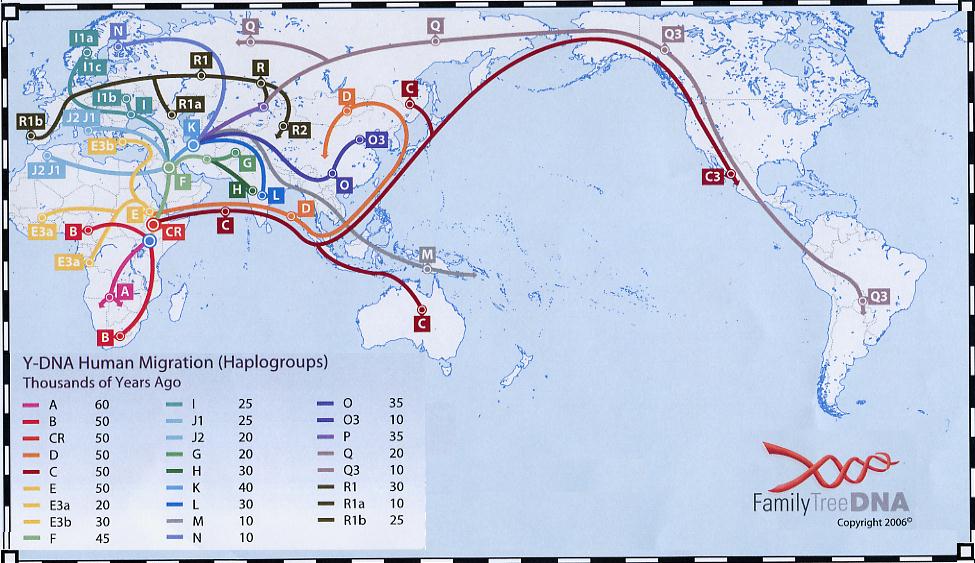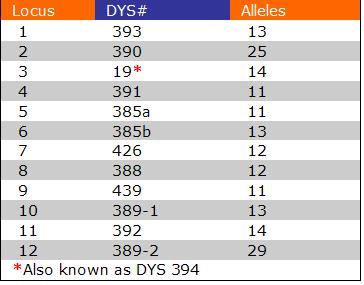DNA Genealogy |
|||
|
for the Marchington family |
|||
|
Iíve been toying with the idea out of interest of doing a DNA sample to see purely out of interest what it tells me about my ancestral back ground being Nordic, Celtic or Saxon. Also its becoming more affordable and there are institution which specializes in the genealogy side of it as away of proving genetic links where records donít exist. I've sent my sample away cost being - $99 US. I will let you know of the results, but in isolation its not much use as proving missing links but I will see what benefits it delivers.
They state/claim that using what they term 12 marker Y-Chromosome test which is a test for the male line they can prove two persons genetic link and they can predict at what generation the two person share the same common ancestor. The 12 marker test is the cheapest but it can tie two people within 7-29 generations. They have other more detailed sampling checks, which can tie the linked generation within more recent generations. If you look at out family this could prove to be fruitful, I hail from John (b1801)& Hannah Marchington of Halsteads farm, Chapel en le Frith branch (Chapel) and we are pretty sure we go all the way back to the first Marchington mentioned in Chapel in 1222 and the paper evidence goes back to Henry Marchington. b1662 and further to Henry's Great Grandfather Phillip who died in 1610 leaving a will. Beyond Henry b1662 the lines of certain families from this point are unclear and as such there are a few branches of the family who come from beyond this date who we cant link them to a common ancestor. Bryan Marchington who also resides in Chapel, comes from the Chapel line but his common ancestor alone with mine is Henry Marchington b1662 & Sarah Potts his branch peeling off at this link proved by paper evidence. A DNA check between these two would confirm the family line back to Henry.1662
These 3 branches could benefit from a Y-DNA test to which the results would be match against Brian & Roberts samples to validate their link and collective the results could throw up a different permutation. I
have setup a MARCHINGTON website at one of the DNA sampling institutions
being Familytreedna
If your order a test kit through our family link you can get it for a reduced cost of $99 that being £66. Also this could prove if we have a link to the Montgomerie family who came over in 1066 as part of the invading Normans Ė thus proving or disproving our link to being of French origin ( well not French but Norman ancestry). Also
my personal DNA sample is displayed on the following website linked to the
Familytreedna institute: This website provided statistic data and links personal DNA samples across families. Also the International Society of Genealogy; http://www.isogg.org/
a 12 marker DNA test gives you 12 sets of numbers termed 'allelese' representing a DNA sequence. These allelese represents mutations. A mutation being where a gene has slightly changed when its been passed on to father to son. By matching these allelese against others you can determine if someone shares a Most Recent Common Ancestor (MRCA) so-long as they share the same surname as both in conjunction gives 90% probability that they are related especial as our name is a rare one. To be sure two individuals with matching 12 marker allelese are related a more detailed sample match can be done this is referred to as a 25 or 37 or 67 marker test. Again if you take a 67 marker test and you match all 67 allelese then you are related and that common ancestor you share would be within 2 to 6 generations, 2 generation is a probability of 50% accuracy within 6 generations gives a probability 99.9% that you share a Common ancestor. Celtic, Saxon or Viking N This haplogroup is distributed throughout Northern Eurasia. It is the most common Y-chromosome type in Uralic speakers (Finns and Native Siberian). This lineage most likely originated in northern China or Mongolia and then spread into Siberia where it became a very common line in western Siberia. R1b Haplogroup R1b is the most common haplogroup in European populations. It is believed to have expanded throughout Europe as humans re-colonized after the last glacial maximum 10-12 thousand years ago. This lineage is also the haplogroup containing the Atlantic modal haplotype. R1b1 Haplogroup R1b1 is the most common haplogroup in European populations. It is believed to have expanded throughout Europe as humans re-colonized after the last glacial maximum 10-12 thousand years ago. This lineage is also the haplogroup containing the Atlantic modal haplotype. R1b1c Haplogroup R1b1c is the most common haplogroup in European populations. It is believed to have expanded throughout Europe as humans re-colonized after the last glacial maximum 10-12 thousand years ago. This lineage is also the haplogroup containing the Atlantic modal haplotype. 7 narrows it down to being of North Atlantic Celtic origin, dominate in Ireland, Scotland and west coast of Briton but not exclusively. If your interested in taking a test follow this link the MARCHINGTON section at familytree DNA. Now there is no point in certain family lines taking part or certian familys having more the 3 members submit samples as this would be a waste of money as such please contact me to see if it would be beneficial for you to take the test. Any questions please ask. Caution: taking a DNA test can be an emotional event as you are proving that your father is your father and your grandfather is you fathers fathers - as such you need to ensure that you are able to cope with the findings should they show the fact that you may have been the son of another man or adopted - so reflection and serious self counseling should be undertaken before doing such tests. DATA OBTAINED FROM MY DNA SAMPLE Robert Marchington.1964, Haplogroup: R1b1c7 = North Atlantic Celt. R1b1c7
is what's termed a 'subclade'
being descendent of the R1b1 group.
The subclade R1b1c7 (M222), is associated with the British Celtic tribes but not exclusively. The relatively high frequency of this specific subclade among the population of certain counties in northwestern Ireland & Scotland may be due to positive social selection - local migration. Not to much should be read into this Irish connection as the subclade just as may be have hailed from another part of Briton and until more wide spread DNA mapping is undertake it cant be exclusively linked to the Western regions of the British Isles. This illustration shows the number of samples that have been submitted in each area and the number of matches to my 12 markers like for like. It clearly shows that hot spots of the same DNA matches are predominately in Ireland and Scotland. Clearly they are related to me/you but some distance away possible 30 generations (750AD). If one of these matches where a Marchington by name then the odds of it being a blood relative is 90% by the fact that the name increases the chances of a match within 30 generations. Again if you take a 67 marker test and you match all 67 allelese then you are related and that common ancestor you share would be within 2 to 6 generations, 2 generation is a probability of 50% accuracy within 6 generations gives a probability 99.9% that you share a Common ancestor with the same name. |
|||
|
|
Results of R P Marchington 12 Marker Test |
||
|
If this subclade R1b1c7 belongs to the Northwest extremes of Briton this throws up a conundrum as to why I have such a gene given the fact that the Marchington's have lived in Chapel en le Frith since 1220 and probably came from the place Marchington which was a Saxon strong hold since the Saxon's arrived after the Romans in 400AD. As such we need more family members and local inhabitants to submit DNA 12 marker samples to enlarge the data. It may be my DNA is of the Milkman's! or way back there was a foster-child or adoption of some sort along the branches of the family or the Marchington's were from a pocket of local Celts in and around Staffordshire / Derbyshire counties who's ancestors moved into the Northern extremes of Briton & Ireland after the Roman invasion or Saxon invasions leaving behind our clan and this clan stayed and mixed with the Romans and later Saxons or some opportunistic Celt moved the other way into Staffordshire / Derbyshire from the northern extremes? We need more samples submitting to understand what are ancestors were up to. Robert P Marchington.1964.
Dated last updated: 22/03/2025
|
|||




